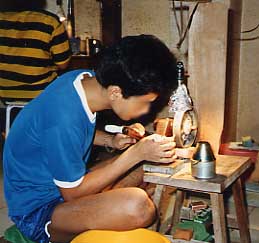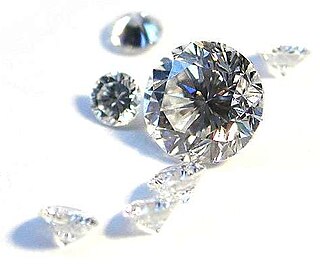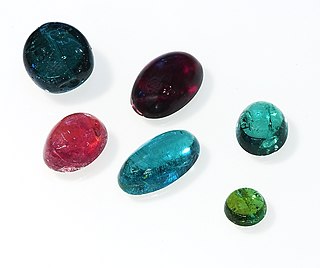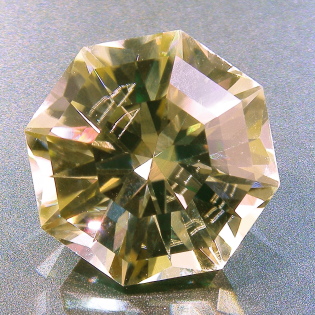
Diamond is a solid form of the element carbon with its atoms arranged in a crystal structure called diamond cubic. At room temperature and pressure, another solid form of carbon known as graphite is the chemically stable form of carbon, but diamond converts to it extremely slowly. Diamond has the highest hardness and thermal conductivity of any natural material, properties that are used in major industrial applications such as cutting and polishing tools. They are also the reason that diamond anvil cells can subject materials to pressures found deep in the Earth.

A gemstone is a piece of mineral crystal which, in cut and polished form, is used to make jewelry or other adornments. However, certain rocks and occasionally organic materials that are not minerals are also used for jewelry and are therefore often considered to be gemstones as well. Most gemstones are hard, but some soft minerals are used in jewelry because of their luster or other physical properties that have aesthetic value. Rarity and notoriety are other characteristics that lend value to gemstones.

A ruby is a pinkish red to blood-red colored gemstone, a variety of the mineral corundum. Ruby is one of the most popular traditional jewelry gems and is very durable. Other varieties of gem-quality corundum are called sapphires. Ruby is one of the traditional cardinal gems, alongside amethyst, sapphire, emerald, and diamond. The word ruby comes from ruber, Latin for red. The color of a ruby is due to the element chromium.

Lapidary is the practice of shaping stone, minerals, or gemstones into decorative items such as cabochons, engraved gems, and faceted designs. A person who practices lapidary is known as a lapidarist. A lapidarist uses the lapidary techniques of cutting, grinding, and polishing. Hardstone carving requires specialized carving techniques.

Diamond cutting is the practice of shaping a diamond from a rough stone into a faceted gem. Cutting diamonds requires specialized knowledge, tools, equipment, and techniques because of its extreme difficulty.

A cabochon is a gemstone that has been shaped and polished, as opposed to faceted. The resulting form is usually a convex (rounded) obverse with a flat reverse. Cabochon was the default method of preparing gemstones before gemstone cutting was developed.

Facets are flat faces on geometric shapes. The organization of naturally occurring facets was key to early developments in crystallography, since they reflect the underlying symmetry of the crystal structure. Gemstones commonly have facets cut into them in order to improve their appearance by allowing them to reflect light.

A diamond cut is a style or design guide used when shaping a diamond for polishing such as the brilliant cut. Cut does not refer to shape, but the symmetry, proportioning and polish of a diamond. The cut of a diamond greatly affects a diamond's brilliance; this means if it is cut poorly, it will be less luminous.

When a gemstone is desired to be used in jewelry, it is cut depending on the size and shape of the rough stone, as well as the desired piece of jewelry to be made. As a general rule, a cut gemstone will reduce the mass by about 50 percent.

The Diamond industry of Israel is an important world player in producing cut diamonds for wholesale. In 2010, Israel became the chair of the Kimberley Process Certification Scheme. As of 2016, cut diamonds constituted 23.2% of Israel's total exports and they were the country's biggest export product, amounting to 12% of the world's production.
A faceting machine is broadly defined as any device that allows the user to place and polish facets onto a mineral specimen. Machines can range in sophistication from primitive jamb-peg machines to highly refined, and highly expensive, commercially available machines. A major division among machines is found between those that facet diamonds and those that do not. Specialized equipment is required for diamond faceting, and faceting as an occupation rarely bridges the gap between diamond and non-diamond workmanship. A second division can be made between industrial faceting and custom/hobby faceting. The vast majority of jewelry-store gemstones are faceted either abroad in factories or entirely by machines. Custom jewelry is still commonly made of custom metalwork and mass-produced gemstones, but unusual cuts or particularly valuable gemstone material will likely be faceted on a personal faceting machine.

Diamond is one of the best-known and most sought-after gemstones. They have been used as decorative items since ancient times.
The Antwerp Diamond Bank (ADB) was a small, 75-year-old bank that specialized exclusively in serving the diamond and the diamond jewelry sector. In addition to its headquarters in Antwerp, it had offices covering all the major traditional as well as emerging diamond centers such as Antwerp, Dubai, Geneva, Hong Kong, Mumbai and New York. ADB became currently a wholly owned subsidiary of KBC Bank, however, European Competition Commission directed KBC to divest the bank as part of the terms of the Belgian government's bail-out of KBC.
ImaGem Inc. is a gem information company based on patented technology for grading and identifying gems. The parent company, ImageStatistics, offers applications in imaging and image processing for the medical, pharmaceutical, manufacturing, chemical and quality assurance industries. ImaGem was created after 20 years of research done on human perception and ImageStatistics, a statistical tool developed by Dr. Lalit K. Aggarwal. ImaGem’s Systems employ advanced optics, imaging technology and proprietary software programs to automate and integrate diamond grading. In addition to evaluating the 4C’s of diamond grading, ImaGem also analyzes Light behavior information based on precise and repeatable measures; three complementary dimensions of brilliance, intensity and sparkle. ImaGem has created a system of uniquely identifying and registering (fingerprinting) a stone without any need for laser inscription. By offering all this information, ImaGem has promoted decision-making and efficiency in the gem industry supply chain. In 1998, ImaGem Inc. was incorporated in the state of Pennsylvania, USA after funding from a major retailer, Ben Franklin Technology Partnership, and private funding. The company has developed an integrated technology to collect image data for diamonds and gemstones, analyze it using direct measurement methodology and grade for precise and repeatable measurements.

Israel Diamond Exchange Ltd., located in the Tel Aviv District city of Ramat Gan, Israel, is the world's largest diamond exchange and the centre of Israel's diamond industry. The exchange is a private company that incorporates about 3100 members; these diamantaires are engaged in diamond cutting and trading - marketing, brokerage, import and export.

Antwerp's diamond district, also known as the Diamond Quarter (Diamantkwartier), and dubbed the Square Mile, is an area within the city of Antwerp, Belgium. It consists of several square blocks covering an area of about one square mile. While as of 2012, much of the gem cutting and polishing work historically done in the neighborhood had moved to low wage centers elsewhere, about 84% of the world's rough diamonds passed through the district, making it the largest diamond district in the world with a turnover of 54 billion dollars. Each year, approximately 50% of the rough diamonds return to Antwerp for cutting and polishing.
The Harry Oppenheimer Diamond Museum was a museum located in the Diamond Exchange District, Tel Aviv District city of Ramat Gan, Israel. The permanent collection consisted of rough and finished diamonds and gemstones and provided information on the history and industry of diamonds. The museum was founded in 1986 in honor of Harry Oppenheimer. Moshe Schnitzer was responsible for establishing the museum and was its Chairman until July 2003. In 2008, the museum was reopened after major renovations. It was closed in 2018.

Moshe Schnitzer was a Romanian Jewish immigrant to Israel who became a key player in the international diamond trade. From 1967 to 1993 he was President of the Israel Diamond Exchange (IDE), which became the world's largest diamond exchange.

The Jains in Belgium are estimated to be around about 1,500 people.
Yitzhak Arie (Leo) Schachter was a prominent Israeli diamantaire and the founder and owner of Leo Schachter Diamonds. Schachter was born in Brooklyn, New York in 1924. A second generation dimantaire, Schachter started his diamond polishing business at the age of 18. He was inspired by his father Max who learnt the art of diamond cutting in Belgium.













